Discover the ultimate guide to selecting the perfect soccer shoe size, ensuring optimal performance and comfort. Learn how to measure, fit, and convert sizes accurately for your needs.
Importance of Proper Fit in Soccer Shoes
A proper fit in soccer shoes is crucial for performance, comfort, and injury prevention. Ill-fitting shoes can lead to blisters, discomfort, and reduced agility on the field. A snug yet comfortable fit ensures better control, stability, and responsiveness during play. Properly fitted shoes also prevent foot fatigue and support overall foot health. Whether you’re a professional or amateur player, investing time in finding the right fit is essential for maximizing your game and avoiding potential discomfort or injuries.
Overview of Key Factors in Choosing Soccer Shoe Size
Choosing the right soccer shoe size involves measuring foot length and width accurately, understanding shoe size charts, and considering the playing surface. Proper fit ensures comfort and performance, while ill-fitting shoes can cause discomfort or injury. Foot shape, width, and personal comfort preferences also play a role. Additionally, shoe size may vary between brands, making it essential to try them on or use reliable size conversion guides. Proper sizing enhances stability, control, and overall gaming experience, making it a critical step in selecting soccer shoes.

How to Measure Your Foot for Soccer Shoes
Accurate foot measurement is crucial for the perfect soccer shoe fit. Use a ruler to measure the longest part of your foot while standing, ensuring precise length and width readings for optimal sizing.
Step-by-Step Guide to Measuring Foot Length and Width
To ensure accuracy, measure your foot while standing on a flat surface, as feet expand under weight. Place a ruler or measurement tool along the longest part of your foot, from the tip of the longest toe to the back of the heel for length. For width, measure across the widest part of the foot, typically just behind the toes. Use a flexible measuring tape or ruler for precise readings. Record both measurements in centimeters to align with size charts. This method ensures a snug, comfortable fit for optimal performance.
Understanding Shoe Size Charts and Conversion
Shoe size charts provide a standardized way to determine your ideal fit by converting foot measurements into corresponding sizes. They typically include length and width measurements in centimeters or inches. Different regions, such as the U.S., U.K., and Europe, use slightly varying scales, so conversion charts are essential for accuracy. By aligning your foot measurements with these charts, you can ensure a proper fit. Always double-check measurements, as slight variations exist between brands. This step is crucial for optimal comfort and performance in your soccer shoes.
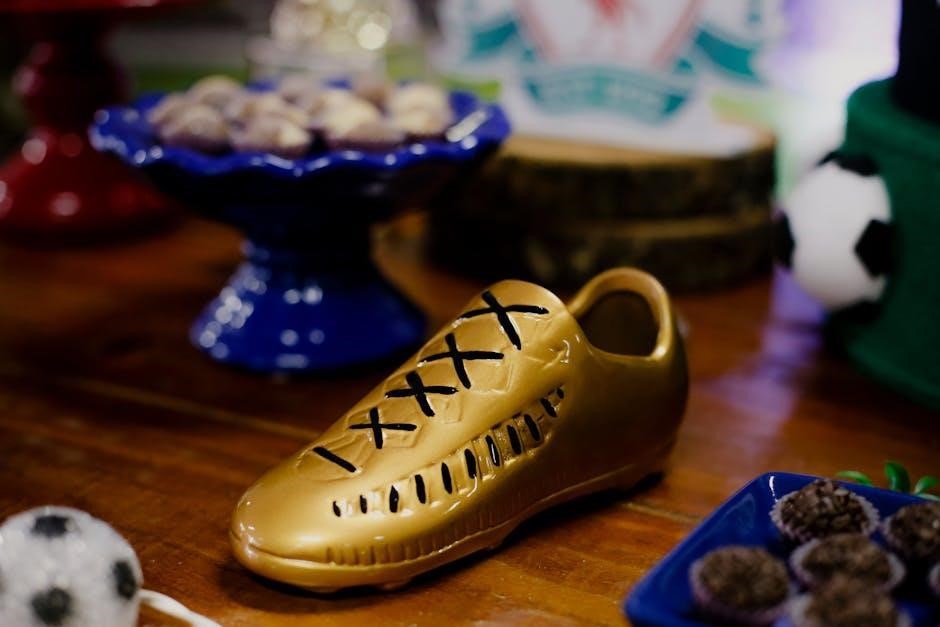
Understanding Soccer Shoe Fit
A proper fit balances snugness and comfort, ensuring optimal performance. The shoe should hug the foot securely, with enough room in the toe box for natural movement.
How Should Soccer Shoes Fit: Snug vs. Comfortable
A proper soccer shoe fit should feel snug but not overly tight, providing support without restricting movement. The toe box should allow toes to wiggle slightly, preventing discomfort. While some players prefer a tighter fit for better control, others prioritize comfort for longer games. The ideal balance depends on foot shape, playing style, and personal preference. Shoes that are too loose may cause blisters, while overly tight shoes can hinder performance. Ensuring the right fit is crucial for both comfort and peak performance on the field.
The Role of the Toe Box in Fit and Comfort
The toe box plays a crucial role in ensuring both fit and comfort in soccer shoes. It should provide enough space for toes to move naturally, preventing discomfort or restriction. A toe box that is too tight can lead to pain and blisters, while excessive space may cause slipping. The ideal fit allows a small amount of room for toe movement without compromising support. Proper toe box fit enhances performance by maintaining stability and comfort during gameplay, making it a key factor in selecting the right soccer shoes.
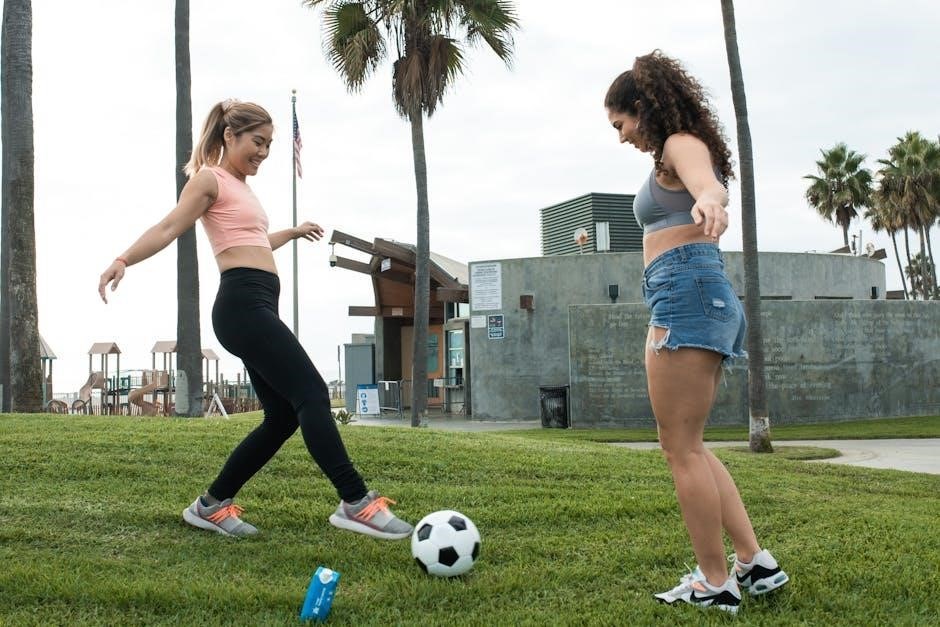
Factors Influencing Soccer Shoe Size
Foot shape, size, and playing surface significantly impact soccer shoe fit. Proper sizing ensures comfort and performance, while incorrect sizing can hinder movement and cause discomfort.
Differences in Foot Shape and Size
Variations in foot shape and size play a crucial role in determining the right soccer shoe fit. Feet come in different lengths, widths, and arch types, which can affect how shoes feel. Narrow or wide feet may require specific shoe styles, while flat feet or high arches might need additional support. Measuring both length and width ensures a more accurate fit, as shoe sizes can vary between brands. Understanding these differences helps in selecting cleats that provide optimal comfort and performance during the game.
Impact of Playing Surface on Shoe Fit
The playing surface significantly influences soccer shoe fit, as different surfaces require varying levels of traction and support. Firm ground cleats, for instance, need a snug fit to ensure stability, while artificial turf shoes may allow for a slightly roomier toe box due to less studs. Soft ground cleats, with longer studs, demand a secure fit to prevent movement. Understanding the surface-specific demands ensures optimal performance and comfort, as improper fit can compromise traction and control during the game.
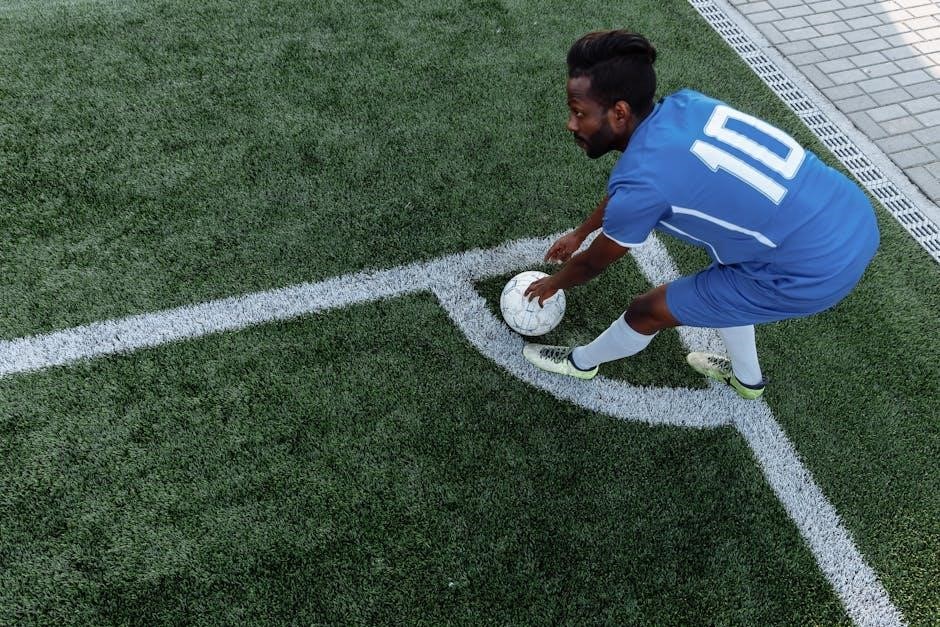
Breaking in Soccer Shoes
Properly breaking in soccer shoes prevents blisters and ensures a snug, comfortable fit. Gradually wear them and consider your foot shape for optimal comfort.
Why Breaking in Shoes is Important
Breaking in soccer shoes ensures comfort and prevents blisters during play. Properly molded shoes enhance performance and reduce injury risks. Start with short sessions, gradually increasing wear time. This allows the material to adapt to your foot shape, providing a snug, natural fit. Ignoring this step can lead to discomfort and poor performance. Different materials and styles may require varied breaking-in approaches, so patience is key for optimal results.
Tips for Breaking in New Soccer Cleats
Start by wearing new cleats for short practice sessions, gradually increasing time. Use the same thickness of socks as during games. Soften stiff areas with a hairdryer or shoe stretcher. Mold the cleats by gently bending and twisting. Avoid forcing them on, as this can cause damage. For snug fits, walk around indoors to shape the shoe to your foot. Proper breaking-in ensures comfort and prevents blisters, enhancing performance on the field.
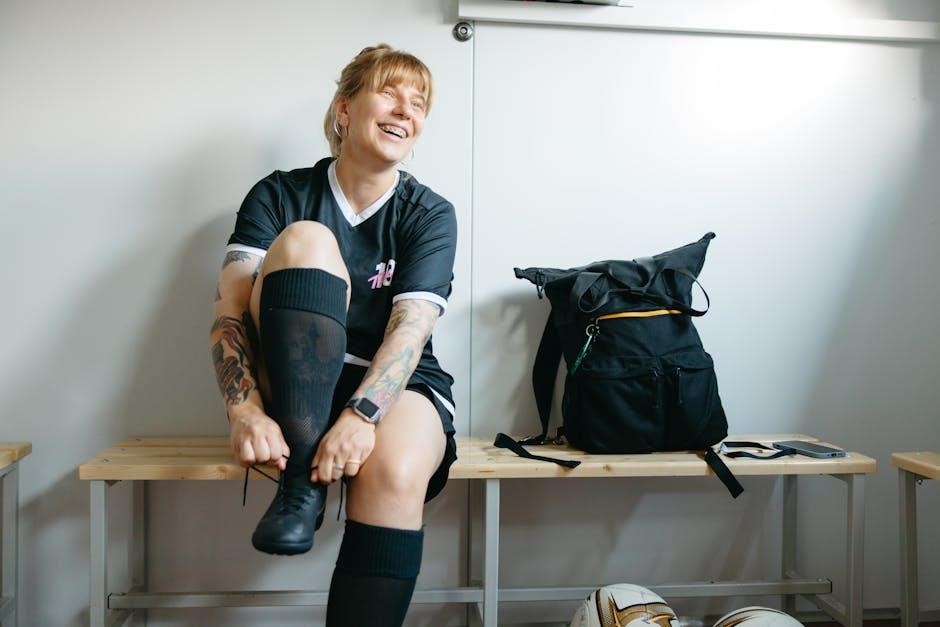
Choosing the Right Cleats for Your Needs
Select cleats based on your playing surface, foot type, and style. Firm-ground cleats suit grass, while indoor shoes are better for artificial turf. Ensure proper fit and traction for optimal performance and comfort.
How to Select Cleats Based on Playing Surface
Choose cleats based on the surface you play on to ensure proper traction and performance. For natural grass, opt for firm-ground cleats with studs for grip. Artificial turf requires shoes with shorter, more numerous studs for durability and control. Indoor surfaces demand non-marking soles for smooth play. Soft-ground cleats, with longer studs, are ideal for muddy fields. Each surface type demands specific cleat features to maximize comfort, stability, and agility. Proper selection enhances your game and reduces injury risks, ensuring optimal fit and performance.
Considering Foot Type and Playing Style
Your foot type and playing style significantly influence cleat selection. Players with narrow feet may prefer snug-fitting shoes, while those with wider feet need roomier options. For speed-focused players, lightweight cleats with a responsive sole are ideal. Control-oriented players benefit from shoes with textured uppers for better ball manipulation. Defensive players might opt for more durable, supportive designs. Understanding your foot type and playing style ensures a tailored fit, enhancing performance and comfort on the field. Proper alignment of these factors is key to optimal shoe selection.

Soccer Shoe Size for Specific Groups
Ensure proper fit for all players, including kids, with varying foot types and playing styles, by considering age, foot shape, and specific needs for optimal performance.
Choosing the Right Size for Kids
Ensuring a proper fit for kids’ soccer shoes is crucial for comfort and performance. Measure their feet regularly, as growth spurts can lead to size changes. Allow a small amount of room for toe movement while maintaining a snug fit. Consider the thickness of socks they’ll wear and test shoes during late afternoon, as feet tend to swell. Avoid guessing sizes; use size charts and try shoes on if possible. Properly fitted shoes can prevent discomfort and injuries, helping kids enjoy the game with confidence and support.
Special Considerations for Wide or Narrow Feet
For individuals with wide or narrow feet, finding the right soccer shoe size requires extra attention. Wide feet benefit from shoes with a roomier toe box, while narrow feet need a snug fit to prevent slipping. Consider brands that cater to specific foot shapes and look for adjustable features like lacing systems. Trying shoes on ensures the best fit, as standard sizes may not accommodate unique foot shapes. Proper fit enhances performance and comfort, making it essential to prioritize foot shape when selecting soccer shoes.
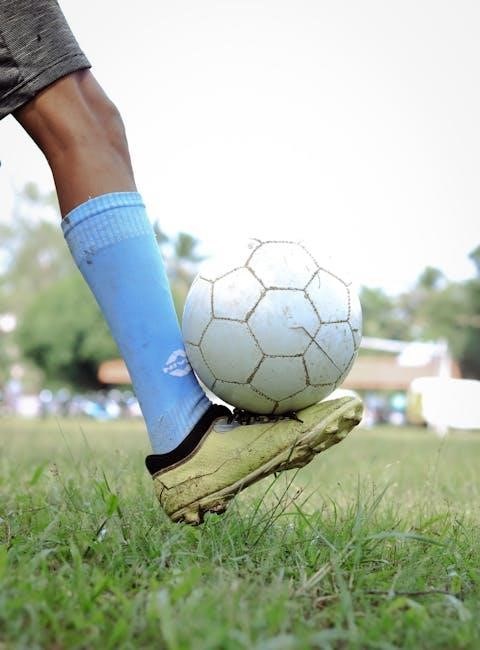
Common Mistakes in Sizing Soccer Shoes
Avoid guessing your size and not considering proper fit. Ill-fitting shoes can cause discomfort and poor performance. Always measure accurately for the best results.
Why You Shouldn’t Guess Your Size
Guessing your soccer shoe size can lead to poor fit, discomfort, and reduced performance. Feet vary in shape and size, and shoe brands differ in sizing standards. Without accurate measurements, you risk tight or loose shoes, causing blisters or lack of control. Proper fit ensures better ball control, speed, and comfort. Always measure your feet and consult size charts to avoid guesswork. Ill-fitting shoes can hinder your game and lead to potential injuries. Take the time to get your size right for optimal performance and comfort.
Consequences of Ill-Fitting Shoes
Ill-fitting soccer shoes can cause discomfort, blisters, and reduced performance. Tight shoes may restrict movement, while loose shoes can lead to poor traction and control. Over time, improper fit can result in foot strain or even long-term injuries like toe deformities. Additionally, ill-fitting cleats can hinder agility and speed, affecting overall gameplay. It’s crucial to prioritize proper fit to avoid these issues and ensure optimal comfort and performance on the field.
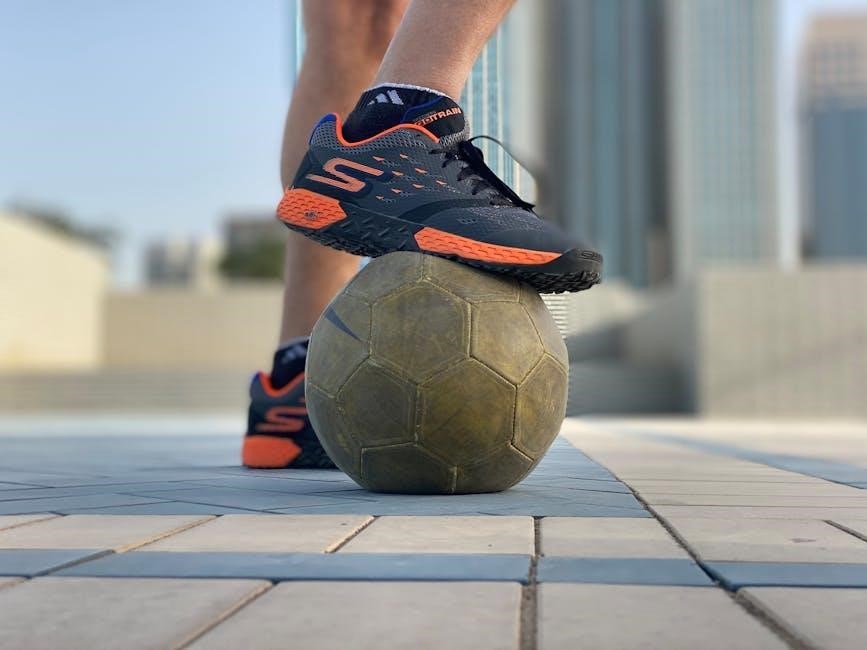
Using Size Conversion Charts
Size conversion charts help align US, UK, and European sizes for accuracy. Use them to avoid mismatches and ensure the perfect fit for your soccer shoes.
US, UK, and European Size Comparisons
Understanding size differences is crucial for a perfect fit. US, UK, and European sizes often vary, with US sizes running larger than UK and European standards. For example, a US size 9 typically corresponds to a UK size 8 and a European size 42. These variations can lead to mismatches if not properly converted. Always consult detailed conversion charts to align your foot length and width with the correct size. This ensures comfort and performance, regardless of the region’s sizing standards.
How to Use Conversion Charts Effectively
Using conversion charts effectively ensures a precise fit when shopping for soccer shoes. Start by measuring your foot length and width accurately. Compare these measurements to the chart, noting how sizes vary across regions. For example, a US size 10 may equate to a UK size 9 or a European size 43. Always check the chart specific to the brand, as sizing can differ slightly. Double-checking your size against international standards helps avoid mismatches. If unsure, consult a professional fitter or use online tools for accurate conversions.
Expert Tips for the Best Fit
Consult a professional fitter for precise measurements and personalized recommendations. Try shoes in the afternoon, as feet tend to swell during the day. Wear the same type of socks you’ll use during games for an accurate fit. Ensure the toe box allows a half-inch of space for comfort and performance.
When to Consult a Professional Fitter
Consult a professional fitter if you have unusual foot shapes, chronic foot pain, or difficulty finding the right size. They can provide precise measurements and recommendations tailored to your needs. A professional fitter can also help if you’re unsure about fit due to foot swelling or if you’re transitioning between brands. They often have expertise in specific shoe technologies and can guide you to the best options for your playing style and foot type, ensuring optimal comfort and performance.
Final Checks Before Purchasing
Before purchasing, ensure the shoes fit comfortably and provide adequate support. Try them on both feet, as sizes can differ slightly. Walk around to check for any tight spots or discomfort. Ensure the cleats feel secure on your intended playing surface. The fit should be snug but allow toe movement. If unsure, consult a professional fitter. Double-check the size chart and reviews for consistency. Finally, verify the return policy in case adjustments are needed. Proper fit is crucial for performance and comfort, so take your time to ensure everything feels right.

Properly fitting soccer shoes enhance performance, prevent injuries, and boost comfort. Use size charts, measure accurately, and try before buying to ensure the best fit for your game.
Key Takeaways for Choosing the Right Soccer Shoe Size
When selecting soccer shoes, prioritize accurate measurements and proper fit. Ensure a snug yet comfortable feel, allowing space for toe movement. Consider foot shape, playing style, and surface type. Use size conversion charts to avoid mismatches. Break in shoes gradually to prevent discomfort. Try shoes on if possible, and consult experts for unique needs. Proper fit enhances performance, reduces injury risk, and boosts confidence, making it essential for players of all levels.
Encouragement to Prioritize Fit and Comfort
Never compromise on fit and comfort when choosing soccer shoes, as it directly impacts performance and injury risk. Properly fitting shoes enhance agility, control, and endurance while reducing discomfort. Prioritize a snug yet comfortable feel, ensuring enough space for toe movement. Avoid tight shoes that restrict natural foot mechanics. Remember, optimal fit boosts confidence and longevity in the game. Always consider foot shape, personal play style, and playing surface when making your decision for the best on-field experience.
